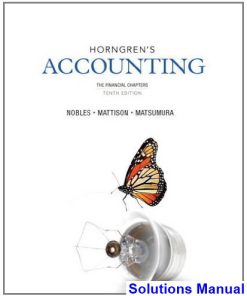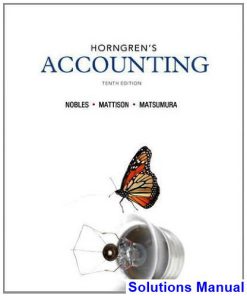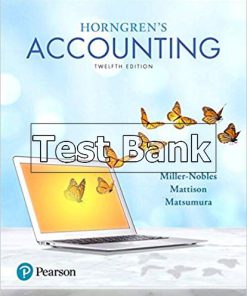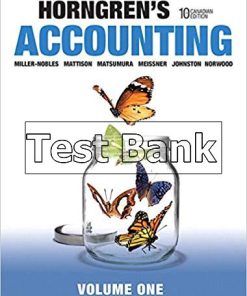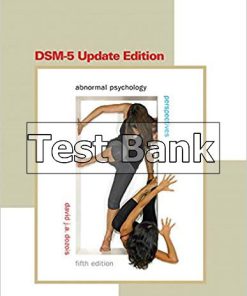Horngrens Accounting 10th Edition Nobles Test Bank
You may also like
Horngrens Accounting 10th Edition Nobles Test Bank
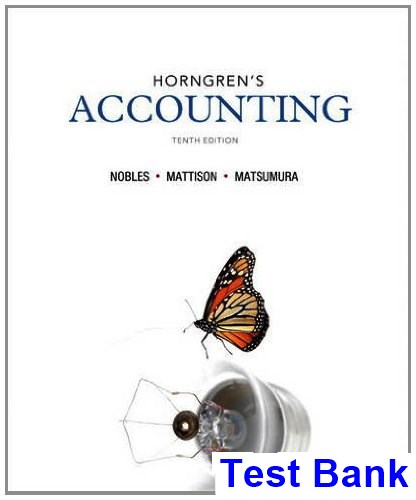
Product details:
- ISBN-10 : 0133117413
- ISBN-13 : 978-0133117417
- Author: Tracie L. Nobles, CPA
The tenth edition of Horngren’s Accounting presents the core content of the accounting course in a fresh format designed to help today’s learners succeed.
Built upon the foundation of the Horngren franchise, this new edition was created by an all-new author team who sought to bridge the gap between textbook content and classroom instruction techniques. New pedagogical features such as Instructor Tips & Tricks and Common Questions, Answered walk students through the material as a great instructor would, fostering deeper understanding of accounting theory and practice.
Table contents:
- Chapter 1 : Accounting and the Business Environment
- Why is Accounting Important?
- Decision Makers: The Users of Accounting Information
- The Accounting Profession
- What are the Organizations and Rules that Govern Accounting?
- Governing Organizations
- Generally Accepted Accounting Principles
- The Economic Entity Assumption
- The Cost Principle
- The Going Concern Assumption
- The Monetary Unit Assumption
- International Financial Reporting Standards
- Ethics in Accounting and Business
- What is the Accounting Equation?
- Assets
- Liabilities
- Equity
- How Do You Analyze a Transaction?
- Transaction Analysis for Smart Touch Learning
- How Do You Prepare Financial Statements?
- Income Statement
- Statement of Owner’s Equity
- Balance Sheet
- Statement of Cash Flows
- How Do You Use Financial Statements to Evaluate Business Performance?
- Green Mountain Coffee Roasters, Inc.
- Return on Assets (ROA)
- Review
- Things You Should Know
- Summary Problem
- Solution
- Key Terms
- Quick Check
- Assess Your Progress
- Review Questions
- Short Exercises
- Exercises
- Problems Group A
- Problems Group B
- Continuing Problem
- Critical Thinking
- Decision Cases
- Ethical Issue 1-1
- Fraud Case 1-1
- Financial Statement Case 1-1
- Team Projects
- Communication Activity 1-1
- Quick Check Answers
- Chapter 2 : Recording Business Transactions
- What is an Account?
- Assets
- Liabilities
- Equity
- Chart of Accounts
- Ledger
- What is Double-Entry Accounting?
- The T-Account
- Increases and Decreases in the Accounts
- Expanding the Rules of Debit and Credit
- The Normal Balance of an Account
- Determining the Balance of a T-Account
- How Do You Record Transactions?
- Source Documents—The Origin of the Transactions
- Journalizing and Posting Transactions
- The Ledger Accounts After Posting
- The Four-Column Account: An Alternative to the T-Account
- What is the Trial Balance?
- Preparing Financial Statements from the Trial Balance
- Correcting Trial Balance Errors
- How Do You Use the Debt Ratio to Evaluate Business Performance?
- Review
- Things You Should Know
- Summary Problem
- Solution
- Key Terms
- Quick Check
- Assess Your Progress
- Review Questions
- Short Exercises
- Exercises
- Problems Group A
- Problems Group B
- Continuing Problem
- Practice Set
- Critical Thinking
- Decision Cases
- Ethical Issue 2-1
- Fraud Case 2-1
- Financial Statement Case 2-1
- Team Project 2-1
- Communication Activity 2-1
- Quick Check Answers
- Chapter 3 : The Adjusting Process
- What is the Difference Between Cash Basis Accounting and Accrual Basis Accounting?
- What Concepts and Principles Apply to Accrual Basis Accounting?
- The Time Period Concept
- The Revenue Recognition Principle
- The Matching Principle
- What are Adjusting Entriesand How Do We Record Them?
- Prepaid Expenses
- Unearned Revenues
- Accrued Expenses
- Accrued Revenues
- What is the Purpose of the Adjusted Trial Balance and How Do We Prepare It?
- What is the Impact of Adjusting Entries on the Financial Statements?
- How Could a Worksheet Help in Preparing Adjusting Entries and the Adjusted Trial Balance?
- Appendix 3A: Alternative Treatment of Recording Prepaid Expenses and Unearned Revenues
- What is an Alternative Treatment of Recording Prepaid Expenses and Unearned Revenues?
- Prepaid Expenses
- Unearned Revenues
- Review
- Things You Should Know
- Summary Problem 3-1
- Solution
- Key Terms
- Quick Check
- Assess Your Progress
- Review Questions
- Short Exercises
- Exercises
- Problems Group A
- Problems Group B
- Continuing Problem
- Practice Set
- Critical Thinking
- Decision Cases
- Ethical Issue 3-1
- Fraud Case 3-1
- Financial Statement Case 3-1
- Team Project 3-1
- Communication Activity 3-1
- Quick Check Answers
- Chapter 4 : Completing the Accounting Cycle
- How Do We Prepare Financial Statements?
- Relationships Among the Financial Statements
- How Could a Worksheet Help in Preparing Financial Statements?
- Section 5—Income Statement
- Section 6—Balance Sheet
- Section 7—Determine Net Income or Net Loss
- What is the Closing Process, and How Do We Close the Accounts?
- Closing Temporary Accounts—Net Income
- Closing Temporary Accounts—Net Loss
- How Do We Prepare a Post-Closing Trial Balance?
- What is the Accounting Cycle?
- How Do We Use the Current Ratio to Evaluate Business Performance?
- Appendix 4A: Reversing Entries: An Optional Step
- What are Reversing Entries?
- Accounting for Accrued Expenses
- Accounting Without a Reversing Entry
- Accounting With a Reversing Entry
- Review
- Things You Should Know
- Summary Problem
- Solution
- Key Terms
- Quick Check
- Assess Your Progress
- Review Questions
- Short Exercises
- Exercises
- Problems Group A
- Problems Group B
- Continuing Problem
- Practice Set
- Critical Thinking
- Decision Case 4-1
- Ethical Issue 4-1
- Fraud Case 4-1
- Financial Statement Case 4-1
- Team Project 4-1
- Communication Activity 4-1
- Comprehensive Problem 1 for Chapters 1–4
- Comprehensive Problem 2 for Chapters 1–4
- Quick Check Answers
- Chapter 5 : Merchandising Operations
- What are Merchandising Operations?
- The Operating Cycle of a Merchandising Business
- Merchandise Inventory Systems: Perpetual and Periodic Inventory Systems
- How are Purchases of Merchandise Inventory Recorded in a Perpetual Inventory System?
- Purchase of Merchandise Inventory
- Purchase Discounts
- Purchase Returns and Allowances
- Transportation Costs
- Cost of Inventory Purchased
- How are Sales of Merchandise Inventory Recorded in a Perpetual Inventory System?
- Sale of Merchandise Inventory
- Sales Discounts
- Sales Returns and Allowances
- Transportation Costs—Freight Out
- Net Sales Revenue and Gross Profit
- What are the Adjusting and Closing Entries for a Merchandiser?
- Adjusting Merchandise Inventory Based on a Physical Count
- Closing the Accounts of a Merchandiser
- Worksheet for a Merchandising Business—Perpetual Inventory System
- How are a Merchandiser’s Financial Statements Prepared?
- Income Statement
- Statement of Owner’s Equity and the Balance Sheet
- How Do We Use the Gross Profit Percentage to Evaluate Business Performance?
- Appendix 5A: Accounting for Merchandise Inventory in a Periodic Inventory System
- How are Merchandise Inventory Transactions Recorded in a Periodic Inventory System?
- Purchases of Merchandise Inventory
- Sale of Merchandise Inventory
- Adjusting and Closing Entries
- Preparing Financial Statements
- Review
- Things You Should Know
- Summary Problem 5-1
- Solution
- Summary Problem 5-2
- Key Terms
- Quick Check
- Assess Your Progress
- Review Questions
- Short Exercises
- Exercises
- Problems Group A
- Problems Group B
- Continuing Problem
- Practice Set
- Critical Thinking
- Decision Cases
- Ethical Issue 5-1
- Fraud Case 5-1
- Financial Statement Case 5-1
- Team Project 5-1
- Communication Activity 5-1
- Comprehensive Problem for Chapters 1–5
- Quick Check Answers
- Chapter 6 : Merchandise Inventory
- What are the Accounting Principles and Controls that Relate to Merchandise Inventory?
- Accounting Principles
- Control Over Merchandise Inventory
- How are Merchandise Inventory Costs Determined Under a Perpetual Inventory System?
- Specific Identification Method
- First-In, First-Out (FIFO) Method
- Last-In, First-Out (LIFO) Method
- Weighted-Average Method
- How are Financial Statements Affected by Using Different Inventory Costing Methods?
- Income Statement
- Balance Sheet
- How is Merchandise Inventory Valued When Using the Lower-of-Cost-or-Market Rule?
- Computing the Lower-of-Cost-or-Market
- Recording the Adjusting Journal Entry to Adjust Merchandise Inventory
- What are the Effects of Merchandise Inventory Errors on the Financial Statements?
- How Do We Use Inventory Turnover and Days’ Sales in Inventory to Evaluate Business Performance?
- Inventory Turnover
- Days’ Sales in Inventory
- Appendix 6A: Merchandise Inventory Costs Under a Periodic Inventory System
- How are Merchandise Inventory Costs Determined Under a Periodic Inventory System?
- First-In, First-Out (FIFO) Method
- Last-In, First-Out (LIFO) Method
- Weighted-Average Method
- Appendix 6B: Estimating Ending Merchandise Inventory
- How Can the Cost of Ending Merchandise Inventory Be Estimated?
- Gross Profit Method
- The Retail Method
- Review
- Things You Should Know
- Summary Problem
- Solution
- Key Terms
- Quick Check
- Assess Your Progress
- Review Questions
- Short Exercises
- Exercises
- Problems Group A
- Problems Group B
- Continuing Problem
- Practice Set
- Critical Thinking
- Decision Cases
- Ethical Issue 6-1
- Fraud Case 6-1
- Financial Statement Case 6-1
- Team Project 6-1
- Communication Activity 6-1
- Quick Check Answers
- Chapter 7 : Accounting Information Systems
- What is an Accounting Information System?
- Effective Accounting Information Systems
- Components of an Accounting Information System
- How are Sales and Cash Receipts Recorded in a Manual Accounting Information System?
- Special Journals
- Subsidiary Ledgers
- The Sales Journal
- The Cash Receipts Journal
- How are Purchases, Cash Payments, and Other Transactions Recorded in a Manual Accounting Information
- The Purchases Journal
- The Cash Payments Journal
- The General Journal
- How are Transactions Recorded in a Computerized Accounting Information System?
- Entry-Level Software
- Enterprise Resource Planning (ERP) Systems
- QuickBooks
- Review
- Things You Should Know
- Summary Problem
- Solution
- Key Terms
- Quick Check
- Assess Your Progress
- Review Questions
- Short Exercises
- Exercises
- Problems Group A
- Problems Group B
- Continuing Problem
- Practice Set
- Critical Thinking
- Decision Cases
- Ethical Issue 7-1
- Fraud Case 7-1
- Team Project 7-1
- Communication Activity 7-1
- Comprehensive Problem for Chapters 1–7
- Quick Check Answers
- Chapter 8 : Internal Control and Cash
- What is Internal Control and How Can It Be Used to Protect a Company’s Assets?
- Internal Control and the Sarbanes-Oxley Act
- The Components of Internal Control
- Internal Control Procedures
- The Limitations of Internal Control—Costs and Benefits
- What are the Internal Control Procedures With Respect to Cash Receipts?
- Cash Receipts Over the Counter
- Cash Receipts by Mail
- What are the Internal Control Procedures With Respect to Cash Payments?
- Controls Over Payment by Check
- How Can a Petty Cash Fund Be Used for Internal Control Purposes?
- Setting Up the Petty Cash Fund
- Replenishing the Petty Cash Fund
- Changing the Amount of the Petty Cash Fund
- How Can the Bank Account Be Used as a Control Device?
- Signature Card
- Deposit Ticket
- Check
- Bank Statement
- Electronic Funds Transfers
- Bank Reconciliation
- Examining a Bank Reconciliation
- Journalizing Transactions From the Bank Reconciliation
- How Can the Cash Ratio Be Used to Evaluate Business Performance?
- Review
- Things You Should Know
- Summary Problem 8-1
- Solution
- Summary Problem 8-2
- Solution
- Key Terms
- Quick Check
- Assess Your Progress
- Review Questions
- Short Exercises
- Exercises
- Problems Group A
- Problems Group B
- Continuing Problem
- Practice Set
- Critical Thinking
- Decision Cases
- Ethical Issue 8-1
- Fraud Case 8-1
- Financial Statement Case 8-1
- Team Project 8-1
- Communication Activity 8-1
- Quick Check Answers
- Chapter 9 : Receivables
- What are Common Types of Receivables and How are Credit Sales Recorded?
- Types of Receivables
- Exercising Internal Control Over Receivables
- Recording Sales on Credit
- Recording Credit Card and Debit Card Sales
- Factoring and Pledging Receivables
- How are Uncollectibles Accounted for When Using the Direct Write-Off Method?
- Recording and Writing Off Uncollectible Accounts—Direct Write-Off Method
- Recovery of Accounts Previously Written Off—Direct Write-Off Method
- Limitations of the Direct Write-Off Method
- How are Uncollectibles Accounted for When Using the Allowa nce Method?
- Recording Bad Debts Expense—Allowance Method
- Writing Off Uncollectible Accounts—Allowance Method
- Recovery of Accounts Previously Written Off—Allowance Method
- Estimating and Recording Bad Debts Expense—Allowance Method
- Comparison of Accounting for Uncollectibles
- How are Notes Receivable Accounted for?
- Identifying Maturity Date
- Computing Interest on a Note
- Accruing Interest Revenue and Recording Honored Notes Receivable
- Recording Dishonored Notes Receivable
- How Do We Use the Acid-Test Ratio, Accounts Receivable Turnover Ratio, and Days’ Sales in Receivab
- Acid-Test (or Quick) Ratio
- Accounts Receivable Turnover Ratio
- Days’ Sales in Receivables
- Review
- Things You Should Know
- Summary Problem 9-1
- Solution
- Summary Problem 9-2
- Solution
- Key Terms
- Quick Check
- Assess Your Progress
- Review Questions
- Short Exercises
- Exercises
- Problems Group A
- Problems Group B
- Continuing Problem
- Practice Set
- Critical Thinking
- Decision Cases
- Ethical Issue 9-1
- Fraud Case 9-1
- Financial Statement Case 9-1
- Team Project 9-1
- Communication Activity 9-1
- Quick Check Answers
- Chapter 10 : Plant Assets, Natural Resources, and Intangibles
- How Does a Business Measure the Cost of a Plant Asset?
- Land and Land Improvements
- Buildings
- Machinery and Equipment
- Furniture and Fixtures
- Lump-Sum Purchase
- Capital and Revenue Expenditures
- What is Depreciation and How is it Computed?
- Factors in Computing Depreciation
- Depreciation Methods
- Partial-Year Depreciation
- Changing Estimates of a Depreciable Asset
- Reporting Plant Assets
- How are Disposals of Plant Assets Recorded?
- Discarding Plant Assets
- Selling Plant Assets
- How are Natural Resources Accounted For?
- How are Intangible Assets Accounted For?
- Accounting for Intangibles
- Specific Intangibles
- Reporting of Intangible Assets
- How Do We Use the Asset Turnover Ratio to Evaluate Business Performance?
- Appendix 10A: Exchanging Plant Assets
- How are Exchanges of Plant Assets Accounted For?
- Exchange of Plant Assets—Gain Situation
- Exchange of Plant Assets—Loss Situation
- Review
- Things You Should Know
- Summary Problem
- Solution
- Key Terms
- Quick Check
- Assess Your Progress
- Review Questions
- Short Exercises
- Exercises
- Problems Group A
- Problems Group B
- Continuing Problem
- Critical Thinking
- Decision Case 10-1
- Ethical Issue 10-1
- Fraud Case 10-1
- Financial Statement Case 10-1
- Team Project 10-1
- Communication Activity 10-1
- Quick Check Answers
- Chapter 11 : Current Liabilities and Payroll
- How are Current Liabilities of Known Amounts Accounted For?
- Accounts Payable
- Sales Tax Payable
- Unearned Revenues
- Short-Term Notes Payable
- Current Portion of Long-Term Notes Payable
- How Do Companies Account for and Record Payroll?
- Gross Pay and Net (Take-Home) Pay
- Employee Payroll Withholding Deductions
- Payroll Register
- Journalizing Employee Payroll
- Employer Payroll Taxes
- Internal Control Over Payroll
- How are Current Liabilities that Must Be Estimated Accounted For?
- Bonus Plans
- Vacation, Health, and Pension Benefits
- Warranties
- How are Contingent Liabilities Accounted For?
- Remote Contingent Liability
- Reasonably Possible Contingent Liability
- Probable Contingent Liability
- How Do We Use the Times-Interest-Earned Ratio to Evaluate Business Performance?
- Review
- Things You Should Know
- Summary Problem 11-1
- Solution
- Summary Problem 11-2
- Solution
- Key Terms
- Quick Check
- Assess Your Progress
- Review Questions
- Short Exercises
- Exercises
- Problems Group A
- Problems Group B
- Continuing Problem
- Critical Thinking
- Decision Cases
- Ethical Issue 11-1
- Fraud Case 11-1
- Financial Statement Case 11-1
- Team Project 11-1
- Communication Activity 11-1
- Quick Check Answers
- Chapter 12 : Partnerships
- What are the Characteristics and Types of Partnerships?
- Partnership Characteristics
- Types of Partnerships
- Other Forms of Business
- How are Partnerships Organized?
- The Start-up of a Partnership
- Partnership Financial Statements
- How are Partnership Profits and Losses Allocated?
- Allocation Based on a Stated Ratio
- Allocation Based on Capital Balances
- Allocation Based on Services, Capital Balances, and Stated Ratios
- Partner Withdrawal of Cash and Other Assets
- Statement of Partners’ Equity
- How is the Admission of a Partner Accounted For?
- Admission by Purchasing an Existing Partner’s Interest
- Admission by Contributing to the Partnership
- How is the Withdrawal of a Partner Accounted For?
- How is the Liquidation of a Partnership Accounted For?
- Sale of Assets at a Gain
- Sale of Assets at a Loss With Capital Deficiency
- Review
- Things You Should Know
- Summary Problem 12-1
- Solution
- Key Terms
- Quick Check
- Assess Your Progress
- Review Questions
- Short Exercises
- Exercises
- Problems Group A
- Problems Group B
- Continuing Problem
- Critical Thinking
- Decision Cases
- Ethical Issue 12-1
- Fraud Case 12-1
- Financial Statement Case 12-1
- Team Project 12-1
- Communication Activity 12-1
- Quick Check Answers
- Chapter 13 : Corporations
- What is a Corporation?
- Characteristics of Corporations
- Stockholders’ Equity Basics
- How is the Issuance of Stock Accounted For?
- Issuing Common Stock at Par Value
- Issuing Common Stock at a Premium
- Issuing Common Stock at a Discount
- Issuing No-Par Common Stock
- Issuing Stated Value Common Stock
- Issuing Common Stock for Assets Other Than Cash
- Issuing Preferred Stock
- How are Dividends and Stock Splits Accounted For?
- Cash Dividends
- Stock Dividends
- Stock Splits
- Cash Dividends, Stock Dividends, and Stock Splits Compared
- How is Treasury Stock Accounted For?
- Treasury Stock Basics
- Purchase of Treasury Stock
- Sale of Treasury Stock
- Retirement of Stock
- How is Equity Reported for a Corporation?
- Statement of Retained Earnings
- Statement of Stockholders’ Equity
- How Do We Use Stockholders’ Equity Ratios to Evaluate Business Performance?
- Earnings per Share
- Price/Earnings Ratio
- Rate of Return on Common Stock
- Review
- Things You Should Know
- Summary Problem 13-1
- Solution
- Key Terms
- Quick Check
- Assess Your Progress
- Review Questions
- Short Exercises
- Exercises
- Problems Group A
- Problems Group B
- Continuing Problem
- Critical Thinking
- Decision Cases
- Ethical Issue 13-1
- Fraud Case 13-1
- Financial Statement Case 13-1
- Team Project 13-1
- Communication Activity 13-1
- Quick Check Answers
- Chapter 14 : Long-Term Liabilities
- How are Long-Term Notes Payable and Mortgages Payable Accounted For?
- Long-Term Notes Payable
- Mortgages Payable
- What are Bonds?
- Types of Bonds
- Bond Prices
- Present Value
- Bond Interest Rates
- Bond Financing Versus Issuing Stock
- How are Bonds Payable Accounted for Using the Straight-Line Amortization Method?
- Issuing Bonds Payable at Face Value
- Issuing Bonds Payable at a Discount
- Issuing Bonds Payable at a Premium
- How is the Retirement of Bonds Payable Accounted for?
- Retirement of Bonds at Maturity
- Retirement of Bonds Before Maturity
- How are Liabilities Reported on the Balance Sheet?
- How Do We Use the Debt to Equity Ratio to Evaluate Business Performance?
- Appendix 14A: The Time Value of Money
- What is the Time Value of Money, and How is the Present Value of a Future Amount Calculated?
- Time Value of Money Concepts
- Present Value of a Lump Sum
- Present Value of an Annuity
- Present Value of Bonds Payable
- Appendix 14B: Effective-Interest Method of Amortization
- How are Bonds Payable Accounted for Using the Effective-Interest Amortization Method?
- Effective-Interest Amortization for a Bond Discount
- Effective-Interest Amortization of a Bond Premium
- Review
- Things You Should Know
- Summary Problem 14-1
- Solution
- Key Terms
- Quick Check
- Assess Your Progress
- Review Questions
- Short Exercises
- Exercises
- Problems Group A
- Problems Group B
- Continuing Problem
- Critical Thinking
- Decision Case 14-1
- Ethical Issue 14-1
- Fraud Case 14-1
- Financial Statement Case 14-1
- Team Project 14-1
- Communication Activity 14-1
- Quick Check Answers
- Chapter 15 : Investments
- Why Do Companies Invest?
- Debt Securities Versus Equity Securities
- Reasons to Invest
- Classification and Reporting of Investments
- How are Investments in Debt Securities Accounted For?
- Purchase of Debt Securities
- Interest Revenue
- Disposition at Maturity
- How are Investments in Equity Securities Accounted For?
- Equity Securities With Less Than 20% Ownership (Cost Method)
- Equity Securities With 20% or More, But Less Than 50%, Ownership (Equity Method)
- Equity Securities With 50% or More Ownership (Consolidations)
- How are Debt and Equity Securities Reported?
- Trading Investments
- Available-for-Sale Investments
- Held-to-Maturity Investments
- How Do We Use the Rate of Return on Total Assets to Evaluate Business Performance?
- Review
- Things You Should Know
- Summary Problem 15-1
- Solutions
- Key Terms
- Quick Check
- Assess Your Progress
- Review Questions
- Short Exercises
- Exercises
- Problems Group A
- Problems Group B
- Continuing Problem
- Critical Thinking
- Decision Case 15-1
- Ethical Issue 15-1
- Fraud Case 15-1
- Financial Statement Case 15-1
- Team Project 15-1
- Communication Activity 15-1
- Quick Check Answers
- Chapter 16 : The Statement of Cash Flows
- What is the Statement of Cash Flows?
- Purpose of the Statement of Cash Flows
- Classification of Cash Flows
- Two Formats for Operating Activities
- How is the Statement of Cash Flows Prepared Using the Indirect Method?
- Cash Flows From Operating Activities
- Cash Flows From Investing Activities
- Cash Flows From Financing Activities
- Net Change in Cash and Cash Balances
- Non-cash Investing and Financing Activities
- How Do We Use Free Cash Flow to Evaluate Business Performance?
- Appendix 16A: Preparing the Statement of Cash Flows by the Direct Method
- How is the Statement of Cash Flows Prepared Using the Direct Method?
- Cash Flows From Operating Activities
- Appendix 16B: Preparing the Indirect Statement of Cash Flows Using a Spreadsheet
- How is the Statement of Cash Flows Prepared Using the Indirect Method and a Spreadsheet?
- Review
- Things You Should Know
- Summary Problem 16-1
- Solution
- Key Terms
- Quick Check
- Assess Your Progress
- Review Questions
- Short Exercises
- Exercises
- Problems Group A
- Problems Group B
- Continuing Problem
- Critical Thinking
- Decision Cases
- Ethical Issue 16-1
- Fraud Case 16-1
- Financial Statement Case 16-1
- Team Projects
- Communication Activity 16-1
- Quick Check Answers
- Chapter 17 : Financial Statement Analysis
- How are Financial Statements Used to Analyze a Business?
- Purpose of Analysis
- Tools of Analysis
- Corporate Financial Reports
- How Do We Use Horizontal Analysis to Analyze a Business?
- Horizontal Analysis of the Income Statement
- Horizontal Analysis of the Balance Sheet
- Trend Analysis
- How Do We Use Vertical Analysis to Analyze a Business?
- Common-Size Statements
- Benchmarking
- How Do We Use Ratios to Analyze a Business?
- Evaluating the Ability to Pay Current Liabilities
- Evaluating the Ability to Sell Merchandise Inventory and Collect Receivables
- Evaluating the Ability to Pay Long-Term Debt
- Evaluating Profitability
- Evaluating Stock as an Investment
- Red Flags in Financial Statement Analyses
- Appendix 17A: The Corporate Income Statement
- How is the Complete Corporate Income Statement Prepared?
- Continuing Operations
- Discontinued Operations
- Extraordinary Items
- Earnings per Share
- Review
- Things You Should Know
- Summary Problem 17-1
- Solution
- Summary Problem 17-2
- Solution
- Key Terms
- Quick Check
- Assess Your Progress
- Review Questions
- Short Exercises
- Exercises
- Problems Group A
- Problems Group B
- Continuing Problem
- Critical Thinking
- Decision Cases
- Ethical Issue 17-1
- Fraud Case 17-1
- Financial Statement Case 17-1
- Team Projects
- Communication Activity 17-1
- Comprehensive Problem for Chapter 17
- Quick Check Answers
- Chapter 18 : Introduction to Managerial Accounting
- Why is Managerial Accounting Important?
- Financial Versus Managerial Accounting
- Management Accountability
- Today’s Business Environment
- Ethical Standards
- How Do Service, Merchandising, and Manufacturing Companies Differ?
- Service Companies
- Merchandising Companies
- Manufacturing Companies
- How are Costs Classified?
- Direct and Indirect Costs
- Product Costs
- Prime and Conversion Costs
- How Do Manufacturing Companies Determine the Cost of Manufactured Products?
- Calculating Cost of Goods Sold
- Calculating Cost of Goods Manufactured
- Flow of Costs Through the Inventory Accounts
- Calculating Unit Product Cost
- How is Managerial Accounting Used in Service and Merchandising Companies?
- Calculating Cost per Service
- Calculating Cost per Item
- Review
- Things You Should Know
- Summary Problem 18-1
- Solution
- Summary Problem 18-2
- Solution
- Key Terms
- Quick Check
- Assess Your Progress
- Review Questions
- Short Exercises
- Exercises
- Problems Group A
- Problems Group B
- Continuing Problem
- Critical Thinking
- Decision Cases
- Ethical Issue 18-1
- Fraud Case 18-1
- Team Project 18-1
- Communication Activity 18-1
- Quick Check Answers
- Chapter 19 : Job Order Costing
- How Do Manufacturing Companies Use Job Order and Process Costing Systems?
- Job Order Costing
- Process Costing
- How Do Materials and Labor Costs Flow Through the Job Order Costing System?
- Materials
- Labor
- How Do Overhead Costs Flow Through the Job Order Costing System?
- Before the Period—Calculating the Predetermined Overhead Allocation Rate
- During the Period—Allocating Overhead
- At the End of the Period—Adjusting for Overallocated and Underallocated Overhead
- What Happens When Products are Completed and Sold?
- Transferring Costs to Finished Goods Inventory
- Transferring Costs to Cost of Goods Sold
- How is the Manufacturing Overhead Account Adjusted?
- Summary
- How Do Service Companies Use a Job Order Costing System?
- Review
- Things You Should Know
- Summary Problem 19-1
- Solution
- Key Terms
- Quick Check
- Assess Your Progress
- Review Questions
- Short Exercises
- Exercises
- Problems Group A
- Problems Group B
- Continuing Problem
- Critical Thinking
- Decision Cases
- Ethical Issue 19-1
- Fraud Case 19-1
- Team Project 19-1
- Communication Activity 19-1
- Quick Check Answers
- Chapter 20 : Process Costing
- How Do Costs Flow Through a Process Costing System?
- Job Order Costing Versus Process Costing
- Flow of Costs Through a Process Costing System
- What are Equivalent Units of Production, and How Do You Calculate Them?
- Equivalent Units of Production
- Conversion Costs
- How is a Production Cost Report Prepared?
- Production Cost Report—First Process—Assembly Department
- Production Cost Report—Second Process—Cutting Department
- What Journal Entries are Required in a Process Costing System?
- How Can the Production Cost Report Be Used to Make Decisions?
- Appendix 20A: Process Costing: First-In, First-Out Method
- How is a Production Cost Report Prepared Using the FIFO Method?
- Comparison of Weighted-Average and FIFO Methods
- Review
- Things You Should Know
- Summary Problem 1
- Summary Problem 1 Solution
- Summary Problem 2
- Summary Problem 2 Solution
- Key Terms
- Quick Check
- Assess Your Progress
- Review Questions
- Short Exercises
- Exercises
- Problems Group A
- Problems Group B
- Critical Thinking
- Decision Case 20-1
- Ethical Issue 20-1
- Team Project 20-1
- Communication Activity 20-1
- Quick Check Answers
- Chapter 21 : Cost-Volume-Profit Analysis
- How Do Costs Behave When There is a Change in Volume?
- Variable Costs
- Fixed Costs
- Mixed Costs
- What is Contribution Margin, and How is it Used to Compute Operating Income?
- Contribution Margin
- Unit Contribution Margin
- Contribution Margin Ratio
- Contribution Margin Income Statement
- How is Cost-Volume-Profit (CVP) Analysis Used?
- Assumptions
- Target Profit—Three Approaches
- Breakeven Point—A Variation of Target Profit
- CVP Graph—A Graphic Portrayal
- How is CVP Analysis Used for Sensitivity Analysis?
- Changes in the Selling Price
- Changes in Variable Costs
- Changes in Fixed Costs
- What are Some Other Ways CVP Analysis Can Be Used?
- Margin of Safety
- Operating Leverage
- Sales Mix
- Appendix 21A: Variable Costing
- How Does Variable Costing Differ From Absorption Costing?
- Absorption Costing
- Variable Costing
- Comparison of Unit Costs
- How Does Operating Income Differ Between Variable Costing and Absorption Costing?
- Production Equals Sales
- Production Exceeds Sales
- Production is Less than Sales
- Summary
- Review
- Things You Should Know
- Summary Problem 21-1
- Solution
- Summary Problem 21-2
- Solution
- Key Terms
- Quick Check
- Assess Your Progress
- Review Questions
- Short Exercises
- Exercises
- Problems Group A
- Problems Group B
- Continuing Problem
- Critical Thinking
- Decision Case 21-1
- Ethical Issue 21-1
- Team Project 21-1
- Communication Activity 21-1
- Quick Check Answers
- Chapter 22 : Master Budgets
- Why Do Managers Use Budgets?
- Budgeting Objectives
- Budgeting Benefits
- Budgeting Procedures
- Budgeting and Human Behavior
- Are There Different Types of Budgets?
- Strategic and Operational Budgets
- Static and Flexible Budgets
- Master Budgets
- How are Operating Budgets Prepared for a Manufacturing Company?
- Sales Budget
- Production Budget
- Direct Materials Budget
- Direct Labor Budget
- Manufacturing Overhead Budget
- Cost of Goods Sold Budget
- Selling and Administrative Expense Budget
- How are Financial Budgets Prepared for a Manufacturing Company?
- Capital Expenditures Budget
- Cash Budget
- Budgeted Income Statement
- Budgeted Balance Sheet
- Budgeted Statement of Cash Flows
- How Can Information Technology Be Used in the Budgeting Process?
- Sensitivity Analysis
- Budgeting Software
- Appendix 22A: Budgeting for Merchandising Companies
- How are Operating Budgets Prepared for a Merchandising Company?
- Sales Budget
- Inventory, Purchases, and Cost of Goods Sold Budget
- Selling and Administrative Expense Budget
- How are Financial Budgets Prepared for a Merchandising Company?
- Capital Expenditures Budget
- Cash Budget
- Budgeted Income Statement
- Budgeted Balance Sheet
- Budgeted Statement of Cash Flows
- Review
- Things You Should Know
- Summary Problem 22-1
- Solution
- Summary Problem 22-2
- Solution
- Key Terms
- Quick Check
- Assess Your Progress
- Review Questions
- Short Exercises
- Exercises
- Problems Group A
- Problems Group B
- Continuing Problem
- Critical Thinking
- Decision Cases
- Ethical Issue 22-1
- Fraud Case 22-1
- Team Project 22-1
- Communication Activity 22-1
- Quick Check Answers
- Chapter 23 : Flexible Budgets and Standard Cost Systems
- How Do Managers Use Budgets to Control Business Activities?
- Performance Reports Using Static Budgets
- Performance Reports Using Flexible Budgets
- Why Do Managers Use a Standard Cost System to Control Business Activities?
- Setting Standards
- Standard Cost System Benefits
- Variance Analysis for Product Costs
- How are Standard Costs Used to Determine Direct Materials and Direct Labor Variances?
- Direct Materials Variances
- Direct Labor Variances
- How are Standard Costs Used to Determine Manufacturing Overhead Variances?
- Allocating Overhead in a Standard Cost System
- Variable Overhead Variances
- Fixed Overhead Variances
- What is the Relationship Among the Product Cost Variances and Who is Responsible for Them?
- Variance Relationships
- Variance Responsibilities
- How Do Journal Entries Differ in a StandardCost System?
- Journal Entries
- Standard Cost Income Statement
- Review
- Things You Should Know
- Summary Problem 23-1
- Solution
- Summary Problem 23-2
- Solution
- Key Terms
- Quick Check
- Assess Your Progress
- Review Questions
- Short Exercises
- Exercises
- Problems Group A
- Problems Group B
- Continuing Problem
- Critical Thinking
- Decision Cases
- Ethical Issues
- Fraud Case 23-1
- Team Project 23-1
- Communication Activity 23-1
- Quick Check Answers
- Chapter 24 : Cost Allocation and Responsibility Accounting
- How Do Companies Assign and Allocate Costs?
- Single Plantwide Rate
- Multiple Department Rates
- Activity-Based Costing
- Traditional Costing Systems Compared to ABC Systems
- Why Do Decentralized Companies Need Responsibility Accounting?
- Advantages of Decentralization
- Disadvantages of Decentralization
- Responsibility Accounting
- What is a Performance Evaluation System and How is it Used?
- Goals of Performance Evaluation Systems
- Limitations of Financial Performance Measurement
- The Balanced Scorecard
- How Do Companies Use Responsibility Accounting To Evaluate Performance in Cost, Revenue, and Profit
- Controllable Versus Noncontrollable Costs
- Responsibility Reports
- How Does Performance Evaluation InInvestment Centers Differ From Other Centers?
- Return on Investment (ROI)
- Residual Income (RI)
- Limitations of Financial Performance Measures
- Appendix 24A: Transfer Pricing
- How Do Transfer Prices Affect Decentralized Companies?
- Objectives in Setting Transfer Prices
- Setting Transfer Prices
- Review
- Things You Should Know
- Summary Problem 24-1
- Solution
- Summary Problem 24-2
- Solution
- Key Terms
- Quick Check
- Assess Your Progress
- Review Questions
- Short Exercises
- Exercises
- Problems Group A
- Problems Group B
- Continuing Problem
- Critical Thinking
- Decision Case 24-1
- Ethical Issue 24-1
- Fraud Case 24-1
- Team Project 24-1
- Communication Activity 24-1
- Quick Check Answers
- Chapter 25 : Short-Term Business Decisions
- How is Relevant Information Used to Make Short-Term Decisions?
- Relevant Information
- Relevant Nonfinancial Information
- Differential Analysis
- How Does Pricing Affect Short-TermDecisions?
- Setting Regular Prices
- Special Pricing
- How Do Managers Decide Which Products to Produce and Sell?
- Dropping Unprofitable Products and Segments
- Product Mix
- Sales Mix
- How do Managers Make Outsourcing and Processing Further Decisions?
- Outsourcing
- Sell or Process Further
- Review
- Things You Should Know
- Summary Problem 25-1
- Solution
- Summary Problem 25-2
- Solution
- Key Terms
- Quick Check
- Assess Your Progress
- Review Questions
- Short Exercises
- Exercises
- Problems Group A
- Problems Group B
- Continuing Problem
- Critical Thinking
- Decision Case 25-1
- Ethical Issue 25-1
- Fraud Case 25-1
- Team Project 25-1
- Communication Activity 25-1
- Quick Check Answers
- Chapter 26 : Capital Investment Decisions
- What is Capital Budgeting?
- The Capital Budgeting Process
- Focus on Cash Flows
- How Do the Payback and Accounting Rate of Return Methods Work?
- Payback
- Accounting Rate of Return (ARR)
- What is the Time Value of Money?
- Time Value of Money Concepts
- Present Value of a Lump Sum
- Present Value of an Annuity
- Summary
- How Do Discounted Cash Flow Methods Work?
- Net Present Value (NPV)
- Internal Rate of Return (IRR)
- Comparing Capital Investment Analysis Methods
- Sensitivity Analysis
- Capital Rationing
- Review
- Things You Should Know
- Summary Problem 26-1
- Solution
- Summary Problem 26-2
- Solution
- Key Terms
- Quick Check
- Assess Your Progress
- Review Questions
- Short Exercises
- Exercises
- Problems Group A
- Problems Group B
- Continuing Problem
- Critical Thinking
- Decision Case 26-1
- Ethical Issue 26-1
- Fraud Case 26-1
- Team Project 26-1
- Communication Activity 26-1
- Quick Check Answers
- Appendix
- Appendix A
- United States Securities and Exchange Commission
- Green Mountain Coffee Roasters, Inc.
- Appendix B
- Present Value Tables
- Future Value Tables
- Glossary
- Subject Index
- Photo Credits
People also search:
horngren’s accounting 10th edition
horngren’s accounting
horngren’s accounting 12th edition answers
horngren’s accounting tenth edition
horngren’s accounting the financial chapters
















